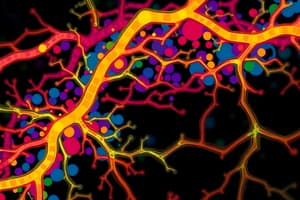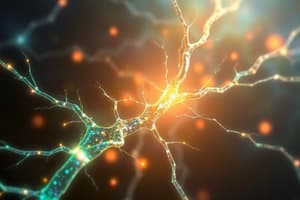Podcast
Questions and Answers
What does the peak-to-peak amplitude primarily measure?
What does the peak-to-peak amplitude primarily measure?
- The conduction time of slower axons
- The fastest axons among the axonal pool (correct)
- The ability of myelinated axons only
- The overall speed of all axons
What does increased latency NOT solely indicate?
What does increased latency NOT solely indicate?
- Neuromuscular transmission time
- Propagation of action potential in the muscle
- Nerve conduction time
- A slow motor conduction velocity (correct)
To accurately measure motor nerve conduction velocity (MNCV), which time needs to be eliminated?
To accurately measure motor nerve conduction velocity (MNCV), which time needs to be eliminated?
- Propagation time in the muscle only
- Both neuromuscular transmission time and propagation time (correct)
- Only the nerve conduction time
- Neuromuscular transmission time only
Which of the following is TRUE regarding latency from a single stimulation site?
Which of the following is TRUE regarding latency from a single stimulation site?
Which aspect does NOT influence the latency from a single site?
Which aspect does NOT influence the latency from a single site?
What is the most common nerve used for motor nerve conduction studies in the thoracic limb?
What is the most common nerve used for motor nerve conduction studies in the thoracic limb?
Where is the recording electrode placed for the ulnar nerve conduction study?
Where is the recording electrode placed for the ulnar nerve conduction study?
Which site is NOT mentioned as a potential recording site for the ulnar nerve?
Which site is NOT mentioned as a potential recording site for the ulnar nerve?
What is the recommended recording site for the sciatic-tibial nerve in the pelvic limb?
What is the recommended recording site for the sciatic-tibial nerve in the pelvic limb?
Which structure assists in locating the elbow recording site for the ulnar nerve?
Which structure assists in locating the elbow recording site for the ulnar nerve?
Study Notes
Measurements in Compound Muscle Action Potential (CMAP)
- Peak amplitude correlates to the number of stimulated axons and activated myofibres.
- An increased amplitude can stem from higher stimulus levels rather than pathology since axon or myofibre counts cannot increase due to disease.
- Consistency in waveform shape at different stimulus sites ensures accurate testing of the same nerve fibres, which is crucial for reliable conduction velocity measurements.
Waveform Analysis
- Polyphasia refers to multiple peaks within a waveform, while temporal dispersion indicates a longer spread of the waveform over time.
- Increased waveform duration suggests varying conduction speeds among axons, leading to multiple potentials being recorded at different times.
Area Under the Curve
- The area under the curve in the waveform reflects the total axonal pool and includes axons with varying conduction velocities, offering a comprehensive view.
- Peak-to-peak amplitude emphasizes only the fastest axons, potentially misrepresenting overall axonal health.
Onset Latency
- Onset latency measures the time from stimulation to the first trace deviation from baseline, indicating the fastest axons' conduction time.
- Latency does not reflect slower, less myelinated axons, limiting its utility in diagnosing certain conditions.
Understanding Latency
- Latency includes not just the nerve conduction time but also neuromuscular transmission time across the neuromuscular junction and action potential propagation across muscle membranes.
- Thus, latency captures more than just motor nerve conduction time.
Variability in Propagation and Transmission Times
- Neuromuscular transmission time and propagation delay are variable among different nerves, affecting latency measurements.
- To accurately assess motor nerve conduction velocity (MNCV), neuromuscular transmission time and muscle action potential generation time must be excluded.
Implications for Motor Nerve Conduction Velocity (MNCV)
- Accurate MNCV measurement requires understanding and accounting for the variable factors affecting latency.
- Eliminating these variables is crucial to isolate MNCV from the latency observed in CMAP recordings.
Motor Nerve Conduction Studies Overview
- Motor nerve conduction studies involve stimulating a mixed or motor nerve and recording activity from a muscle.
- Commonly used nerves include the ulnar nerve for the thoracic limb and the sciatic tibial nerve for the pelvic limb.
Ulnar Nerve in Thoracic Limb
- The ulnar nerve is predominantly utilized in the thoracic limb.
- Stimulation occurs on the medial aspect of the limb.
- Recording from the palmar interosseus muscle involves placing the reference electrode subcutaneously nearby.
- The ground electrode is positioned near the accessory carpal bone.
Recording Sites for Ulnar Nerve
- Key recording sites include:
- Proximal Site: Mid humerus, caudal to biceps brachii.
- Elbow Site: Located in the groove between the olecranon and medial epicondyle, referred to as the "funny bone."
- Distal Site: Just above the accessory carpal bone, near the flexor carpii ulnaris tendon.
Data Collection for Ulnar Nerve
- Record latency from both elbow and carpus sites.
- Measure the distance between the elbow and carpus to calculate nerve conduction velocity.
Sciatic-Tibial Nerve in Pelvic Limb
- The sciatic-tibial nerve is chosen for recording in the pelvic limb.
- Placement of the recording electrode occurs in the plantar interosseus muscle with the reference over the metatarsals.
- The ground electrode is positioned over the calcaneus.
Stimulation Sites for Sciatic-Tibial Nerve
- Stimulation can occur at three sites:
- Hip Site: Identify the notch caudal to the greater trochanter of the femur for electrode placement.
- Stifle Site: Positioned caudal to the distal edge of the femur, lateral to the fabellae.
- Hock Site: Located at the neurovascular bundle between the Achilles tendon and distal tibia, proximal to the calcaneus.
Studying That Suits You
Use AI to generate personalized quizzes and flashcards to suit your learning preferences.
Description
This quiz focuses on the relationship between peak amplitude and the stimulation of working axons and myofibres. It explores how changes in amplitude can inform us about muscle activation without indicating pathology. Understand the implications of amplitude variations in neuroscience.




